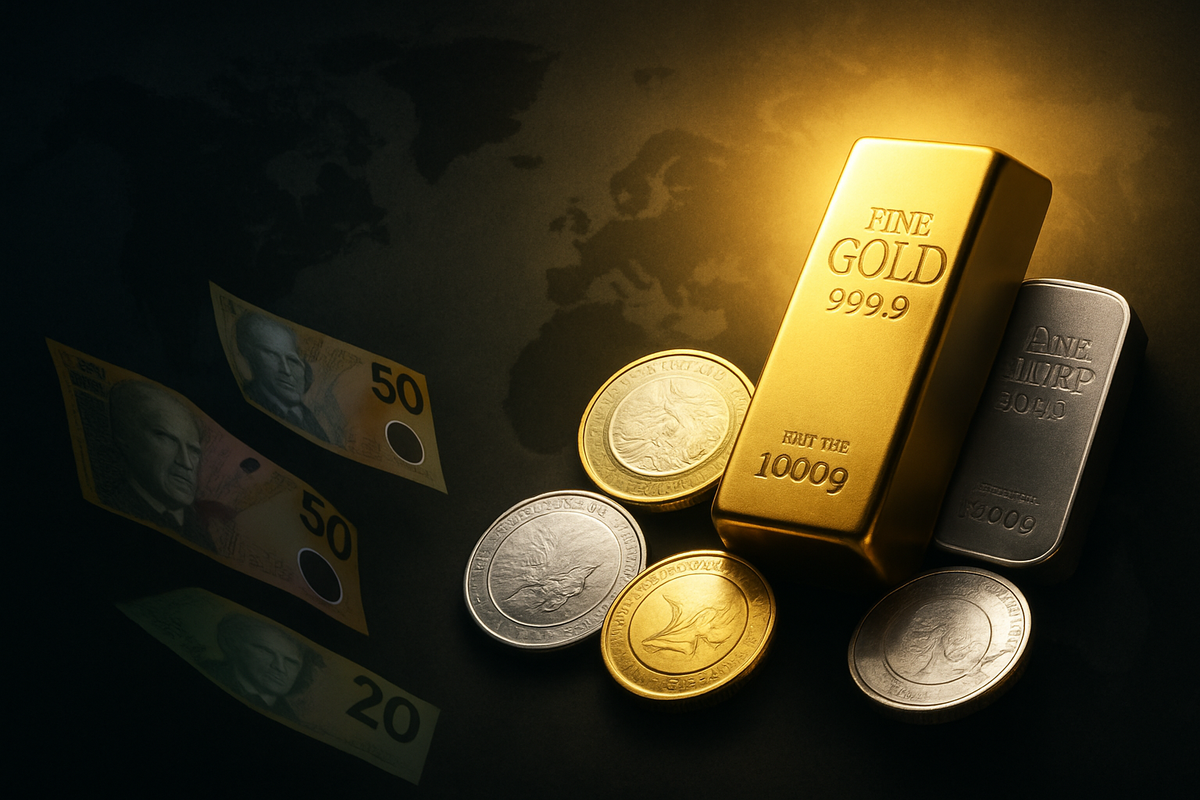
The global financial landscape is currently marked by a significant and sustained underperformance of commodity currencies, a trend largely driven by a renewed wave of global trade tensions, divergent monetary policies, and weakening domestic economic indicators in key exporting nations. This pervasive "risk-off" sentiment among investors has immediate and profound implications across the broader financial market, most notably bolstering the appeal and prices of traditional safe-haven assets, particularly gold and silver.
As of mid-October 2025, currencies like the New Zealand Dollar (NZD) and Australian Dollar (AUD) have experienced notable slumps against the US dollar, signaling a widespread retreat from risk-sensitive assets. This flight from commodity-linked currencies is directly fueling an unprecedented rally in precious metals, with gold breaking above $4,000 per ounce and silver surging past $50 per ounce, both reaching new all-time highs. This dynamic suggests a deep-seated investor concern over economic stability and a strong preference for tangible assets perceived as hedges against inflation and geopolitical uncertainty.
Detailed Coverage: A Retreat from Risk-Sensitive Currencies
The narrative of commodity currency underperformance has been a defining feature of the financial markets through much of 2025, intensifying into the latter part of the year. This broad-based decline has swept across a spectrum of currencies, including the New Zealand Dollar (NZD), Australian Dollar (AUD), Canadian Dollar (CAD), Brazilian Real (BRL), Colombian Peso (COP), Chilean Peso (CLP), South African Rand (ZAR), and Mexican Peso (MXN), driven by a powerful confluence of dovish central bank policies, weakening economic fundamentals, and renewed geopolitical and trade uncertainties.
A critical timeline of events underscores this trend. The second quarter of 2025 revealed significant economic contraction in key commodity-exporting nations. New Zealand's economy shrank by 0.9% quarter-on-quarter, with annual GDP down 0.7%, and manufacturing and construction sectors experiencing notable slumps. Simultaneously, Australia's unemployment rate climbed to a four-year high of 4.5% in September, following sluggish job growth, signaling a softening labor market. These domestic weaknesses provided fertile ground for central banks to adopt more accommodative stances.
The Reserve Bank of New Zealand (RBNZ) acted decisively on October 8, 2025, delivering an unexpected "jumbo" rate cut of 50 basis points, lowering its Official Cash Rate (OCR) to 2.50%. This aggressive move, aimed at stimulating a flagging economy and bringing inflation to target, sent the NZD/USD pair tumbling to its lowest level since April. Following suit, expectations for a Reserve Bank of Australia (RBA) rate cut have surged, with market futures by mid-October indicating a 76% chance of a November rate reduction, largely in response to the deteriorating labor market data.
Further exacerbating the "risk-off" environment were renewed global trade tensions. In October 2025, former US President Donald Trump announced fresh 100% tariffs on Chinese imports, slated to take effect from November 1st, alongside new export controls. These threats, coming after a brief period of eased tariffs, injected significant uncertainty into global trade, directly impacting commodity prices and the currencies of nations heavily reliant on trade with China, such as Australia and New Zealand. The combined effect of these factors has triggered a pronounced shift towards traditional safe-haven assets. The US Dollar (USD), Japanese Yen (JPY), and Swiss Franc (CHF) have all seen increased inflows, while precious metals like gold and silver have experienced an unprecedented surge. Gold briefly touched $4,078 per ounce, and silver spiked above $51.7, as investors sought refuge from the turbulent economic and geopolitical currents.
Companies Navigating a Bifurcated Market
The current financial climate, characterized by depreciating commodity currencies and soaring precious metals prices, presents a starkly bifurcated landscape for public companies. While gold and silver miners are poised for significant gains, companies heavily reliant on commodity currency stability for exports or those utilizing precious metals as critical industrial inputs face considerable headwinds.
The underperformance of commodity currencies, often tied to nations whose economies hinge on raw material exports, means a devalued local currency against stronger counterparts like the U.S. dollar. This depreciation can be a double-edged sword. On one hand, it makes exports cheaper for international buyers, potentially boosting volumes and local currency revenues for producers. Companies operating in these environments might also see operational costs (labor, local raw materials) decrease when translated into a stronger foreign currency, thereby improving profit margins. For instance, a gold miner in Australia, selling gold in USD but incurring costs in a weaker AUD, would see expanded margins.
Conversely, a weaker local currency translates directly into higher costs for imported goods and services. Companies that rely on imported raw materials, machinery, or intermediate goods will face increased production expenses, squeezing profit margins. Manufacturing firms in commodity-exporting nations that import specialized components will find their input costs rising. Furthermore, companies with significant foreign currency-denominated debt will discover that servicing these obligations becomes more expensive in local currency terms. This can lead to inflationary pressures, reduced domestic purchasing power, and potentially lower demand for goods and services.
The unprecedented surge in gold and silver prices, with gold surpassing $4,200 per ounce and silver exceeding $53 per ounce in mid-October 2025, is a clear boon for precious metals mining companies and streaming/royalty firms. Higher metal prices directly translate to increased revenues and profit margins, incentivizing these companies to boost production, explore new deposits, and expand existing operations. Major gold miners like Newmont (NYSE: NEM), Barrick Gold (NYSE: GOLD), and Agnico Eagle Mines (NYSE: AEM) are prime beneficiaries, seeing substantial increases in the value of their extracted metals relative to their all-in sustaining costs of production. Similarly, silver-focused companies such as Pan American Silver (NASDAQ: PAAS), First Majestic Silver (NYSE: AG), and Hecla Mining Company (NYSE: HL) are experiencing a significant uplift. Streaming companies like Wheaton Precious Metals (NYSE: WPM), which purchase metals at fixed, discounted prices, are particularly well-positioned to profit from rising prices with reduced operational risks.
However, the surge in silver prices poses a significant challenge for industries that rely on silver as a critical industrial input. Silver is an indispensable component in photovoltaic cells for solar panels, electric vehicles (EVs), and advanced electronics due to its superior electrical conductivity. The solar industry alone consumes over 130 million ounces of silver annually in 2025, with forecasts predicting a 170% increase in demand from solar PV panel manufacturers by 2030. Companies like First Solar (NASDAQ: FSLR) and Enphase Energy (NASDAQ: ENPH), along with other renewable energy manufacturers, will face increased manufacturing expenses due to the rising cost of silver. This could squeeze profit margins, potentially leading to higher end-product prices and affecting demand if consumers are price-sensitive. These companies may need to innovate to reduce their reliance on silver or secure long-term supply contracts to mitigate the impact on their market position.
Wider Significance: A Shifting Global Economic Order
The concurrent underperformance of commodity currencies and the unprecedented surge in precious metals prices are not isolated events but rather profound indicators of a significant recalibration within the global financial and economic landscape. This dynamic is deeply intertwined with several overarching industry trends, including an accelerating de-dollarization movement, the ongoing energy transition, and increasing geopolitical fragmentation.
The relentless rally in precious metals, with gold spot prices touching $4,179.48 per ounce in October 2025 – a near 100% appreciation since early 2024 – and silver surging 70% year-to-date to surpass its 1980 record at $51.71 per ounce, strongly reflects an accelerating de-dollarization trend. Central banks and sovereign wealth funds are visibly reducing their reliance on the U.S. dollar, converting reserves into gold. The U.S. dollar's share of global foreign exchange reserves has declined to 58.4% in Q1 2025, a stark drop from approximately 71% in 2000. This structural shift provides sustained institutional demand for gold and silver as alternative reserve assets, as countries and investors seek to diversify holdings and hedge against perceived risks to the dollar's safe-haven status. This erosion of dollar dominance is particularly evident in commodity markets, where an increasing proportion of energy contracts are now priced in non-dollar denominations.
The energy transition also plays a dual and complex role. While the global shift towards cleaner energy systems fuels robust demand for critical minerals like copper, lithium, nickel, cobalt, and especially silver – essential for renewable energy infrastructure and electric vehicles – it simultaneously impacts traditional commodity currencies. Silver, with its crucial industrial uses in solar panels and electronics, is seeing demand forecast to reach record levels in 2025. Conversely, currencies of economies heavily reliant on fossil fuel exports, such as the Norwegian Krone (NOK) and Canadian Dollar (CAD), face persistent weakening as global demand for oil and gas diminishes due to stricter climate policies and the promotion of renewable energy. This directly affects their trade balances and exchange rates, creating a divergence between "green" commodity-linked currencies and traditional fossil fuel-linked ones.
Geopolitical fragmentation further exacerbates these trends. Heightened international tensions, exemplified by renewed US-China trade conflicts, ongoing regional disputes, and a broader move towards deglobalization and protectionism, foster widespread economic uncertainty. This "risk-off" sentiment drives investors towards safe-haven assets like gold and silver, which are strategically accumulated by central banks for geopolitical risk mitigation. Fragmentation in commodity markets, intensified since the Russia-Ukraine conflict, can lead to extreme price volatility and supply chain disruptions, particularly for critical minerals. IMF research suggests that in a fragmented world, critical mineral prices could be 300% higher than in integrated markets, potentially increasing the cost of the energy transition.
The ripple effects are far-reaching. Commodity-exporting nations (excluding precious metals) may face economic slowdowns, increased currency volatility, and challenges in managing inflation and growth. Precious metal producers, conversely, are experiencing significant revenue boosts and margin expansion. For global trade and supply chains, increased protectionism and currency volatility disrupt established networks, inflate costs, and stifle business investment. The shift away from traditional financial assets towards tangible assets like gold and silver also signals a deeper apprehension about the stability of fiat currencies and traditional financial instruments, prompting capital rotation and revised portfolio strategies across financial markets.
In terms of regulatory and policy implications, central banks are under immense pressure to manage inflation while supporting growth amidst currency devaluation fears. Governments are likely to explore strategic commodity reserves, implement export controls, and offer domestic production incentives to safeguard national interests. The de-dollarization trend could fragment the international monetary system along geopolitical lines, necessitating new forms of multilateral cooperation on trade policies. Historically, the current surge in gold and silver prices draws parallels to the rampant inflation of the 1970s and early 1980s, when gold soared amidst economic turmoil, and to the post-2008 financial crisis, reinforcing its role as a crisis hedge. However, the present rally is distinguished by its orderly progression and strong fundamental underpinnings related to monetary policy shifts, geopolitical tensions, and a growing "debasement trade" – where investors bet against governments' ability to manage ballooning global debt and deficits.
What Comes Next: Navigating a New Market Paradigm
The road ahead for commodity currencies and precious metals promises a dynamic and potentially volatile journey, shaped by persistent global economic shifts, evolving geopolitical tensions, and the accelerating demands of industrial innovation. While precious metals are broadly expected to maintain a bullish trajectory, the path for commodity currencies remains intricately linked to global growth, monetary policy divergence, and the ongoing redefinition of international trade.
In the short-term (next 6-12 months), precious metals are poised for continued bullish momentum, albeit with intermittent volatility. Gold prices are projected to reach $4,400 per ounce by year-end 2025 and potentially peak near $4,600 by mid-2026, driven by persistent inflation concerns, ongoing geopolitical instability, and sustained central bank buying. The anticipated rate-cutting cycle by the Federal Reserve is expected to further reduce the opportunity cost of holding non-yielding assets like gold. Silver is also forecast to continue its remarkable rally, potentially hitting $57.50 per ounce by mid-2026, with some aggressive projections reaching $65. Its dual role as a monetary and industrial metal, combined with its smaller market size, often allows it to outperform gold in percentage terms. Platinum has surged to 11-year highs due to severe supply constraints and is expected to remain strong, benefiting from deficits and increasing industrial demand. However, analysts caution that gold, silver, and platinum are currently "severely overbought," suggesting the potential for short-term corrections of 10-20% as profit-taking occurs. Palladium, while having experienced recent rallies, faces structural headwinds from the global shift towards electric vehicles, which do not use the metal.
Looking further out (beyond 12 months), the long-term outlook for gold remains predominantly bullish, with some forecasts ranging from an average of $4,150 per ounce in 2026 to aggressive targets of $6,000 per ounce under specific conditions, underpinned by continued central bank accumulation and a global distrust in fiat currencies. Silver is anticipated to outperform gold in the long run, potentially reaching $75-77 per ounce by 2026-2027, largely driven by its increasingly critical industrial role in the green energy transition. Platinum's long-term prospects are also bright, primarily fueled by the burgeoning hydrogen economy, with demand from fuel cell applications expected to increase significantly, potentially pushing prices to $100 by 2028 and even $200 by 2034.
For commodity currencies, the short-term outlook (next 6-12 months) is heavily influenced by the expected weakening of the U.S. dollar, which could provide a tailwind by making their exports more competitive and boosting commodity prices. However, a sharper-than-expected slowdown in global economic growth, exacerbated by worsening trade relations, could depress commodity demand and weaken these currencies. In the long term, structural economic shifts, particularly the energy transition, will play a decisive role. Currencies of countries heavily reliant on traditional fossil fuel exports may face persistent headwinds, while those linked to critical minerals for green technologies could see long-term support. Geopolitical fragmentation and the desire for greater financial autonomy, especially among BRICS nations, could also lead to shifts in global trade and investment patterns, indirectly affecting the demand and stability of commodity currencies.
Strategic pivots and adaptations will be crucial for businesses and governments. Businesses in the commodity sector should diversify their portfolios to include commodities benefiting from the green energy transition and build more resilient, localized supply chains. Robust hedging strategies are essential for companies exposed to commodity currency volatility. Governments, meanwhile, are likely to continue diversifying their foreign exchange reserves by increasing gold holdings and strategically investing in industries that process critical minerals for green technologies. Monetary policy adaptations will be necessary for central banks in commodity-producing nations to manage inflation and currency volatility.
Market opportunities for commodity currencies include a potentially weaker U.S. dollar and specific commodity booms driven by industrial demand, while challenges stem from global growth slowdowns, geopolitical volatility, and inflation risks. For precious metals, opportunities lie in their continued role as an inflation hedge and safe haven, growing industrial demand (especially for silver and platinum), and persistent central bank buying. Challenges include short-term price volatility, "overbought" conditions that suggest potential corrections, and palladium's long-term structural headwinds from the shift to EVs.
Potential scenarios range from a base case of moderate inflation and persistent geopolitical tensions, where precious metals continue their upward trend with corrections and commodity currencies benefit from a weaker U.S. dollar, to high inflation/recession scenarios that would see a strong surge in gold and silver. Conversely, a global stability/strong growth scenario might diminish gold's safe-haven appeal, while intensified geopolitical fragmentation could lead to continued strong safe-haven buying for gold and strategic demand for critical minerals. Ultimately, the coming months and years will be a period of significant transition, demanding foresight, adaptability, and robust risk management from all market participants.
Wrap-Up: A Regime Shift Towards Real Assets
The latter half of 2024 and the early part of 2025 have unveiled a significant divergence in global financial markets, marked by the pronounced underperformance of commodity-linked currencies and an unprecedented surge in precious metals. This shift is not merely a cyclical fluctuation but rather a "regime shift" and a "structural repricing" of real assets, reflecting a complex interplay of macroeconomic forces, geopolitical fragmentation, and evolving investor sentiment that is reshaping the global financial landscape.
Key Takeaways
The underperformance of commodity currencies, such as the Australian Dollar (AUD), New Zealand Dollar (NZD), and Canadian Dollar (CAD), stems from a confluence of factors. A resilient U.S. dollar, buoyed by robust U.S. economic data and a slower pace of Federal Reserve interest rate easing, has made commodity-linked currencies less attractive. Renewed fears of a "second trade war" and potential tariffs on Chinese goods, particularly by the new U.S. administration, have injected significant uncertainty into global trade, impacting major partners of commodity-exporting nations and raising concerns about lower global commodity prices. Despite substantial liquidity injections, China's economic recovery has not fully materialized, dampening demand for raw materials. Additionally, persistent underlying inflation in some commodity-producing economies has limited their central banks' ability to cut interest rates aggressively and thus reducing currency appeal.
Conversely, gold and silver have experienced a remarkable rally, reaching unprecedented highs. This surge is driven by heightened economic and geopolitical uncertainty, including ongoing conflicts, trade disputes, and concerns about overall economic stability. Monetary policy shifts, particularly the Federal Reserve's recent interest rate cuts and anticipated further easing in 2025, have reduced the opportunity cost of holding non-yielding assets. Furthermore, gold and silver are perceived as strong hedges against inflationary pressures and fears of currency debasement, exacerbated by substantial government debt and ongoing fiscal expansion. A critical driver has been the record central bank demand, particularly from emerging markets diversifying reserves away from the U.S. dollar. Increased investment demand, reflected in significant inflows into gold-backed Exchange-Traded Funds (ETFs), further underscores this trend. Silver, in particular, benefits from its dual role as a monetary safe-haven and its surging industrial demand from sectors like electrification, artificial intelligence, and green energy, where it faces a persistent supply deficit.
Assessment of the Market Moving Forward
The near-term outlook for commodity currencies remains uncertain, especially for the first half of 2025. Continued strong U.S. economic data that delays Fed rate cuts, coupled with sustained trade tensions, could prolong their weakness. J.P. Morgan Research suggests a bearish view for cyclical currencies, anticipating that U.S. economic data may moderate to align with global trends.
For precious metals, the consensus among analysts points to a sustained bullish trend for gold and silver through 2025 and 2026.
- Gold Price Projections: Major financial institutions like J.P. Morgan, Goldman Sachs, and Bank of America forecast gold prices ranging from an average of $3,675/oz by Q4 2025 to potentially reaching $4,000/oz by mid-2026, with some projections even reaching $5,000/oz or higher by 2026.
- Silver Price Projections: Silver is expected to continue its strong performance, with forecasts ranging from $57.50/oz by mid-2026 to $65/oz by 2026, and even more aggressive projections pointing towards $75-77/oz by 2026-2027, driven by its industrial demand and relative undervaluation to gold.
- Drivers for Continued Rally: The ongoing factors of central bank purchasing, sustained investor demand, an anticipated weakening of the U.S. dollar through 2026, and persistent geopolitical and economic uncertainties are expected to underpin this upward trajectory.
Broader commodities (excluding precious metals) are projected to decline in 2025 due to improved supplies, policy uncertainty, and an expected slowdown in global economic growth. Energy prices (oil, natural gas) are forecast to fall in 2025 and 2026, driven by global production growth outpacing demand and expanding LNG supplies. Agricultural prices are also expected to decline gradually due to ample grain supplies. Industrial metals like copper could see a more sustained upcycle due to a structural deficit from underinvestment and a recovery in global demand outside of China.
Final Thoughts on Significance and Lasting Impact
The current market dynamics suggest a "regime shift" and a "structural repricing" of real assets, rather than just a cyclical fluctuation. This reflects a fundamental recalibration within the global financial landscape. The aggressive central bank gold accumulation signifies a growing distrust in the long-term stability of the U.S. dollar and a strategic move towards greater financial autonomy by many nations, indicating a lasting impact on global reserve asset allocation.
For investors, precious metals are increasingly seen as an "optimal hedge" against a unique combination of risks, including stagflation, recession probabilities, currency debasement, and U.S. policy uncertainties. This enduring role as a safe haven is expected to persist as a core investment strategy. The surge also highlights potential challenges for industries reliant on precious metals, such as jewelry and electronics manufacturing, facing higher input costs and potentially "slammed" margins.
What Investors Should Watch For in Coming Months
Investors should closely monitor several key indicators:
- Federal Reserve Monetary Policy: The pace and extent of future interest rate cuts by the Fed will significantly influence the U.S. dollar's strength and the attractiveness of non-yielding assets like precious metals.
- Geopolitical Developments: Any escalation or de-escalation of conflicts, trade disputes (especially between the U.S. and China), and other sources of political instability will continue to drive safe-haven flows into precious metals.
- Inflationary Pressures: Signs of persistent or resurging inflation will further bolster the appeal of gold and silver as hedges against purchasing power erosion.
- U.S. Dollar Performance: Continued weakening of the U.S. dollar would generally support dollar-denominated commodities, including precious metals.
- Central Bank Activity: Keep an eye on reports regarding central bank gold purchases, as this structural demand is a significant underlying support for prices.
- Global Economic Indicators: Data on global economic growth, particularly from China, will influence demand for broader commodities and, consequently, the performance of commodity currencies.
- Supply-Demand Dynamics for Specific Commodities: Monitor production levels and industrial demand, especially for silver (green energy, AI) and industrial metals like copper, which are projected to face structural deficits.
- Investment Flows into ETFs: Sustained or increasing inflows into gold and silver ETFs will indicate continued investor confidence and momentum in precious metals.
This content is intended for informational purposes only and is not financial advice





